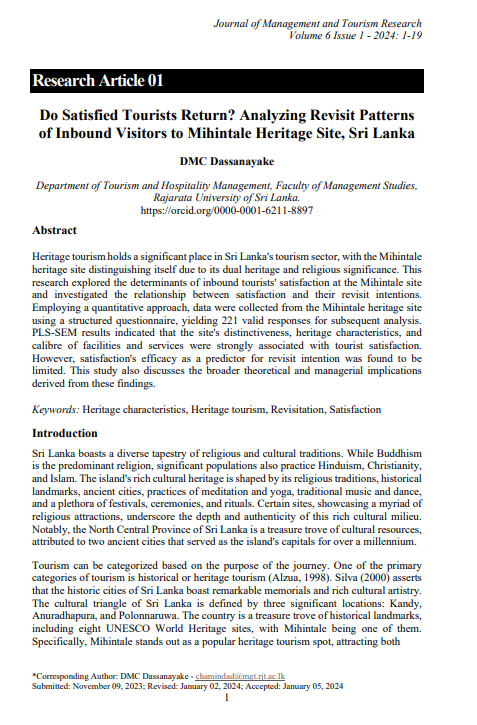Volume 07, Issue 01
TABLE OF CONTENTS
01. A Study on Visit Intention and Tourist Experience at Fashion Events in Sri Lanka: Special Reference to Colombo District
I.W.G.A.S.V. Gunawardana1 C.P. Danthanarayana 2 U.G.O. Sammani3
INFORMATION
Journal Title: Journal of Management and Tourism Research
Volume : 7 Issue : 01
Page : 1- 15
I.W.G.A.S.V. Gunawardana1 C.P. Danthanarayana 2 U.G.O. Sammani3
1,2,3 Department of Tourism Studies, Faculty of Management, Uva Wellassa University of Sri Lanka
2 https://orcid.org/0000-0001-6344-706X
3 https://orcid.org/ 0000-0003-3591-290X
ABSTRACT
This study aims to investigate visit intention and tourist experiences within the context of fashion events in Sri Lanka, with special reference to the Colombo district. The research objectives encompass an exploration of the influence of fashion event characteristics on tourist experiences mediated by visit intention in fashion events to the broader tourism industry in Sri Lanka. A quantitative research approach was utilized for the study. Data was collected from the 120 fashion events participants and convenience sampling technique was used as sampling technique. A semi-structured questionnaire was used to collect the data while Partial Least Squared Structural Equation Modeling (PLS-SEM) was used to analyze data. The main findings showed that the characteristics of fashion events have a positive influence on visit intention, while positively impacting the tourist experience. Visit intention was found to play a significant fully mediating the relationship between characteristics of fashion event and tourist experience. The study recommends some policy implications such as creating a unique identity for fashion events can contribute to the preservation of the cultural heritage. The country can promote its cultural identity and preserve its rich history by incorporating traditional elements into modern fashion
Key Words : : Characteristics of fashion events, fashion industry, fashion tourism, tourist experience, visit intention
02. Understanding the Dynamics of Backpacker Tourism in Sri Lanka: Insights into Traveller Motivations and Supplier Strategies
M.T. Pathirana1, T.K. Vimukthika2, U.S. Warnakula3 M. De Silva4, D.K. Hettiarachchi5
INFORMATION
Journal Title: Journal of Management and Tourism Research
Volume : 7 Issue : 01
Page : 17- 45
M.T. Pathirana1, T.K. Vimukthika2, U.S. Warnakula3 M. De Silva4, D.K. Hettiarachchi5
1,2,3,4 Edith Cowan University Sri Lanka
5Sri Lanka Institute of Tourism and Hospitality Management
1 https://orcid.org/0000-0001-8784-3833
2 https://orcid.org/0000-0001-9712-0364
ABSTRACT
Backpacker tourism has emerged as a transformative segment within Sri Lanka’s tourism industry, offering significant opportunities for sustainable development and cultural exchange. This study examines the motivations, preferences, and decision-making processes of backpackers, alongside the strategies employed by tourism suppliers to engage this unique traveller segment. Employing the Theory of Planned Behaviour (TPB) as a framework, the research draws on qualitative data from interviews with 56 backpackers and 42 tourism suppliers across the key destinations in Sri Lanka. Findings reveal that backpackers are primarily influenced by the aspects of affordability, cultural richness, and eco-conscious experiences, while peer recommendations and social media play a pivotal role in their decision-making. Tourism suppliers, in response, have tailored their offerings to include budget-friendly accommodations, immersive cultural activities, and sustainable practices, leveraging digital marketing to enhance engagement. This study highlights the socio economic benefits of backpacker tourism particularly its contribution to the local communities and the promotion of eco-friendly initiatives. By addressing the evolving needs of this segment, stakeholders can maximize its potential to foster long-term growth in the tourism industry. The findings provide practical recommendations for enhancing the backpacker experience while reinforcing Sri Lanka’s position as a premier destination for culturally immersive and sustainable travel.
Key Words : : Backpacker tourism, marketing strategies, Sri Lanka, suppliers, sustainability
03. Assessing the Impact of Instagram Hotspots on Travelers’ Destination Choice: Empirical Evidence from Sri Lanka
H.C. Gurusinghe1, C.J.P. Kulathilaka2, G.H.V. Harshani3
INFORMATION
Journal Title: Journal of Management and Tourism Research
Volume : 7 Issue : 01
Page : 47- 63
H.C. Gurusinghe1, C.J.P. Kulathilaka2, G.H.V. Harshani3
1,3 Department of Tourism Studies, Faculty of Management, Uva Wellassa University of Sri
Lanka
2 Department of Management Sciences, Faculty of Management, Uva Wellassa University of
Sri Lanka
2 https://orcid.org/0009-0004-4726-1870
3 https://orcid.org/0000-0002-8139-5360
ABSTRACT
The rise of social media platforms, notably Instagram, has fundamentally altered the landscape of how individuals share and consume travel experiences. Instagram, with its visual-centric nature, user-generated content, and social validation mechanisms such as likes and comments, has become a powerful tool in influencing travelers’ perceptions and decisions about their preferred destinations. Instagram exposes travelers to captivating imagery, personal stories, and peer recommendations, shaping their travel aspirations and preferences. Using a quantitative research methodology, this study aims to examine how Instagram hotspots influence traveler choice and how online trust functions as a mediator between Instagram hotspots and traveler choice. A sample of 384 Instagram users of Generation Y was determined as the sample size using the convenience sampling technique. Structured self-administered questionnaires were distributed to collect the primary data, and Structural Equation Modelling through Smart PLS was applied to analyze the data. The research found that Instagram hotspots significantly influence destination choice, with online trust partially mediating this relationship. This study’s findings shed light on the relationship between Instagram content, user engagement, and destination choices, offering Sri Lanka’s tourism stakeholders valuable insights for strategic decision-making. The insights from this study empower stakeholders to enhance their promotional strategies and resource allocation. By understanding the factors influencing travelers’ choices and preferences, tourism authorities and businesses can customize their marketing campaigns, craft targeted messaging, and create engaging content that resonates with their audience. By understanding the factors that influence travelers’ choices, tourism authorities and businesses can tailor their marketing campaigns, develop targeted messaging, and create engaging content that resonates with their audience.
Key Words : : Destination choice, destination promotion, Instagram hotspots, online trust, travelers’ behavior, User-Generated Content
04. Visitor Insights at Colombo National Museum: Marketing Mix Analysis Based on TripAdvisor Reviews
G.B.I. Weerasinghe
INFORMATION
Journal Title: Journal of Management and Tourism Research
Volume : 7 Issue : 01
Page : 65- 80
G.B.I. Weerasinghe
Department of Archaeology, University of Kelaniya, Sri Lanka
https://orcid.org/0000-0002-4894-7370
ABSTRACT
Colombo National Museum (CNM) in Sri Lanka is an ideal attraction to reflect the country’s historical evidence from the prehistoric era of the contemporary society. Foreign visitors’ arrivals to the CNM are considerably low compared to the total of tourist arrivals to Sri Lanka. This study bridges the empirical gap where the visitor experience at CNM has not been explored by the researchers adequately. The purpose of this study is to explore the visitors’ insights on the visit experience at Colombo National Museum, based on TripAdvisor reviews regarding the marketing mix elements. This qualitative study employed secondary data from the TripAdvisor platform. TripAdvisor is one of the most widely used platforms for online reviews. Out of 1107 English reviews, the most recent, the first 100 reviews were considered in data collection. Employing thematic analysis, data were analyzed utilizing the deductive approach, utilizing the concept of 7 Ps in marketing mix, where 7 elements are applied in services i.e., Product, Price, Place, Promotion, People, Process, and Physical Evidence. The study reveals that the visitors’ positive perceptions of the ‘Product’ element are depicted in informative galleries, rich antiquities, and exhibits. In contrast, their negative insights on ‘Product’ are primarily reflected in the unavailability of evidence from the colonial period. ‘Price’ appeared to be a considerable factor due to the price discrepancy between locals and foreigners. The study indicates limited criticisms of ‘Place’, ‘Promotion’, ‘People’, and ‘Process’. ‘Physical Element’ is the most negatively emphasized aspect due to the issues in ventilation, interior illumination, seating arrangements, and exhibit arrangement. The study reveals that the reflection of visitor experience at CNM through online platforms is not at an extremely high level. The findings of the study highlight the significance of personalized visitor experience and urge the accountable authorities to determine and address the prevailing issues effectively, ensuring the visitors’ satisfaction and the site’s reputation.
Key Words : : Colombo National Museum, marketing mix, TripAdvisor reviews, visitor experience, visitor insights
05. The Influence of Strategic Planning on the Business Performance of Small and Medium Enterprises in Sri Lanka: Mediating Role of Dynamic Capabilities
F.M. Fairoz
INFORMATION
Journal Title: Journal of Management and Tourism Research
Volume : 7 Issue : 01
Page : 81- 99
F.M. Fairoz
Department of Management and Entrepreneurship, University of Ruhuna, Sri Lanka
https://orcid.org/0009-0009-2119-1735
ABSTRACT
This study examines the mediating effect of Dynamic Capabilities (DC) in the relationship between Strategic Planning (SP) and Business Performance of SMEs in the Southern province of Sri Lanka. Dynamic capabilities are imperative for SMEs in their strategic planning process to overcome the challenges posed by the COVID-19 pandemic and economic crisis in Sri Lanka. A questionnaire survey was conducted by selecting 250 SMEs from the Southern province of Sri Lanka, and data were analyzed using Structural Equation Modeling (SEM) through Partial Least Squares (PLS). The findings indicate that there is a positive and significant influence of SP on performance. Results further confirm that there is a significant positive effect of SP and DC, as well as DC and the performance of SMEs. The study also confirms that DC partially mediates the relationship between SP and the performance of SMEs. The present study provides valuable insights for academics, policymakers, and industry practitioners. Further, the study contributes to the literature by confirming the mediating role of dynamic capabilities in the relationship between strategic planning and performance of SMEs. Findings provide practical implications for the SME owners, policy makers, business development service organizations, and government to take corrective actions to enhance the strategic planning and dynamic capabilities to enhance the performance of SMEs.
Key Words : : Business performance, dynamic capabilities, small and medium enterprises, Sri Lanka, strategic planning
06. The Role of Technological Advancement and E-Marketing on Business Performance of SMEs in Sri Lanka
B.E.A. Jayasekara
INFORMATION
Journal Title: Journal of Management and Tourism Research
Volume : 7 Issue : 01
Page : 101- 121
B.E.A. Jayasekara
Department of Science for Technology, Faculty of Technology, University of Sri Jayawardenepura, Sri Lanka
https://orcid.org/0009-0004-7433-5353
ABSTRACT
Small and medium – sized enterprises (SMEs) are significant drivers of innovation, employment and economic growth, especially in developing countries like Sri Lanka. However, SMEs encounter challenges to incorporate technology innovations and e–marketing tactics which are crucial for overall business performance and competitiveness in an increasingly digitalize corporate setting. Although the existing body of literature emphasizes the advantages of digital transformation on businesses, research on the effects of technology advancements and e–marketing techniques on business performance of SMEs in emerging nations like Sri Lanka remains unexplored. This study aims to bridge these gaps by examining the relationship between technology advancements (TA), e-marketing (EMT) and SME business performance which is evaluated through key performance indicators of SMEs (KPIs) such as sales growth, customer satisfaction and market reach. A quantitative research approach is used, with data collected from 300 SMEs across various industries in Sri Lanka according to stratified proportional sampling technique using a structured questionnaire. The findings suggest that both technology advancements and e – marketing activities have a positive relationship with key performance indicators of SMEs in Sri Lanka, however TA has an insignificant relationship and EMT has a significant relationship with KPIs of SMEs. These results illustrate that SMEs in Sri Lanka can improve their overall business performance by integrating more e – marketing strategies into their marketing approach. Based on the findings, this paper provides suggestions for SMEs to make use of data–driven decision making, partnerships with digital service providers and cultivate a digitalize culture in order to achieve competitiveness in the market. Additionally, the study adds to the body of existing literature by offering empirical evidence on the importance of digital transformation in SME performance.
Key Words : : Customer satisfaction, digital transformation, e – marketing, market reach, small and medium-sized enterprises, sales growth, technological advancement
07. Impact of Visual Merchandizing on Consumer’s Willingness to Purchase with the Moderating Role of Generations in Sri Lankan Fashion Retailers
G.P.K. Nishadi
INFORMATION
Journal Title: Journal of Management and Tourism Research
Volume : 7 Issue : 01
Page : 123- 138
G.P.K. Nishadi
Department of Marketing, Faculty of Management and Finance, University of Ruhuna, Sri Lanka
https://orcid.org/0000-0001-7800-5926
ABSTRACT
The process of deliberately positioning objects in a retail setting in order to draw customers, produce an engaging shopping experience, and eventually increase sales is known as visual merchandizing. In the retail sector, visual merchandising has a significant impact on consumers’ propensity to buy. However, the intended research findings are insufficient to determine how visual merchandising influences customers’ propensity to buy, particularly in the setting of Sri Lanka. Furthermore, Sri Lanka’s heterogeneous age makeup adds complexity to this relationship. Therefore, the goal of this study is to determine how visual merchandising components affect consumers’ propensity to buy while taking into account the moderating influence of generations. Primary data were collected from 200 respondents living in Western Province in Sri Lanka based on the convenience sampling method. Results indicated that color and lighting have a substantial beneficial impact on consumer purchase intention, with product display having the highest impact. Furthermore, these associations were found to be significantly moderated by generation, with various generations responding differently to consumer’s willingness to purchase. In addition to strongly moderating the relationship between color and lighting on consumers’ willingness to purchase, generations also significantly moderate the relationship between store layout and consumer willingness to purchase. These findings have significant practical ramifications for retailers and marketers involved in the Sri Lankan retail industry. Retailers can better serve the preferences of various demographic segments by customizing their marketing campaigns and optimizing their store surroundings by knowing the elements that influence willingness to purchase and how Generations moderate these interactions.
Key Words : : Colour & lighting, cleanliness, generations, product display, store layout, willingness to purchase
08. Exploring the Critical Sustainable Practices of Community Based Tourism Entrepreneurs for Enhancing the Destination Competitiveness in Rural Tourism Destinations: A Sri Lankan Perspective
G.T.W. Sriyani1, F.M. Fairoz2
INFORMATION
Journal Title: Journal of Management and Tourism Research
Volume : 7 Issue : 01
Page : 139 – 163
G.T.W. Sriyani1, F.M. Fairoz1
1,2Department of Management and Entrepreneurship, Faculty of Management and Finance, University of Ruhuna, Sri Lanka
1https://orcid.org/0000-0002-3870-1561
2https://orcid.org/0009-0009-2119-1735
ABSTRACT
Community-based Tourism (CBT) is recognized as a tool for empowering rural communities to start and manage diverse tourism-related livelihoods, improving their quality of life, and alleviating poverty. Although the majority of CBT businesses are operated on a small-scale level, it is necessary to apply sustainable practices for their success, long-term existence, and enhanced destination competitiveness. In the Sri Lankan context, there is a lack of research based on the visitors’ perceptions about the sustainability practices of community-based tourism entrepreneurs (CBTEs), which affects for enhancing the destination competitiveness. This research aims to fill this knowledge gap mainly because it is important for practitioners and policymakers in the tourism industry. The interpretivism research approach and purposive sampling technique were applied in this study, and data were collected from the three selected rural community tourism villages in Sri Lanka. The guests highly appreciated the sustainability practices of CBTEs in the two villages relating to the environmental, social & cultural, and economic dimensions, while less appreciation was received for one of the villages selected for this study. Not having a proper training about sustainability practices and mandatory requirements of running community-based tourism businesses, and a lack of monitoring process seem as reasons behind such a less concern. The majority of the interviewed tourists mentioned that relating to the three aspects of sustainability dimensions, product and service quality; diverse range and novelty of the products and services; well trained and skilled people; cooperativeness as a community and strong leadership; security and safety; and follow the mandatory rules, regulations, and standards effect on enhancing the destination competitiveness in the selected villages. Therefore, much attention needs to be given by practitioners and policymakers on these aspects for enhancing the competitiveness in CBT destinations.
Key Words : : Community-based tourism entrepreneurs, destination competitiveness, Sri Lanka, sustainability practices, visitor perception
10. Spirituality and Entrepreneurial Mindset: A Soulful Path to Sustainable Entrepreneurial Journey
H.M.J.C.B. Heenkenda1, H.M.G.Y. Hennayake2, D.F. Dissanayake3, E.S. Wickramasekera4
INFORMATION
Journal Title: Journal of Management and Tourism Research
Volume : 7 Issue : 01
Page : 183- 200
H.M.J.C.B. Heenkenda1, H.M.G.Y. Hennayake2, D.F. Dissanayake3, E.S. Wickramasekera4
1, 4 The Open University of Sri Lanka
2, 3 Gampaha Wickramarachchi University of Indigenous Medicine
1 https://orcid.org/0000-0002-2124-4501
2 https://orcid.org/0000-0003-1191-8450
3 https://orcid.org/0000-0002-0828-6256
ABSTRACT
The role of spirituality in entrepreneurship is a new area of inquiry that has emerged from different scholarly fields. There is no specific way to study spirituality, as it rather depends on the context and influence of the human mindset. This paper aims to study the integration of spirituality in the entrepreneurial journeys of individual entrepreneurs in Sri Lanka. Thereby focusing on the factors that provide reassurance for entrepreneurs to practice their spiritual mindset in an emerging market context. This study used the qualitative research method and the purposive sampling technique. Drawing on thematic analysis, it identifies a three-stage process: discerning, affirming, and materializing a spiritual mindset. These mindsets are shaped by lifelong learning and trust-based business relationships. The findings suggest that spirituality can positively influence business practices and performance. The study proposes a framework for incorporating spirituality into business mission and vision, with implications for entrepreneurial education and development in emerging markets. Spirituality can alter the entrepreneurial nature of a business. This means that entrepreneurs who possess a high spiritual mindset can incorporate their spirituality within specific business functions to enable a more positive outcome. Further, this study also examines how entrepreneurs integrate their spiritual and entrepreneurial mindset into their path to a sustainable business journey in the context of Sri Lanka.
Key Words : : Entrepreneurial journey, entrepreneurial mindset, spirituality, sustainability



